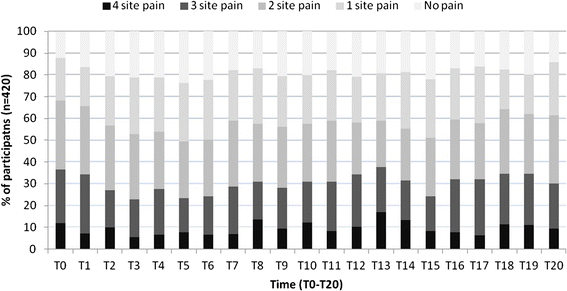Multisite musculoskeletal pain among young technical school students entering working life
- PMID: 26879595
- PMCID: PMC4754996
- DOI: 10.1186/s12891-016-0938-6
Multisite musculoskeletal pain among young technical school students entering working life
Abstract
Background: There is a need to investigate the occurrence of multisite pain in young adults and to determine potential factors contributing to the early course of multisite musculoskeletal pain. The aim of this prospective study was to assess the occurrence and change of prevalence in the number of pain sites. We also wanted to identify work-related and individual risk factors associated with the number of musculoskeletal pain sites.
Methods: We monitored musculoskeletal pain from 4 body regions, individual and work-related factors on 21 occasions over a 6.5 year period. The cohort consisted of 420 technical school students entering working life. Data were analyzed by generalized estimating equations (GEE).
Results: Pain from more than one body site was prevalent in this cohort of young adults (69 % at baseline), and the number of body sites in pain was found quite stable over the 6.5 year follow-up period. Women had higher number of pain sites compared with men and gender specific risk factors were identified. Increased mechanical workload and quantitative demands and low socioeconomic status were associated with increased number of musculoskeletal pain sites among women, while tobacco use was found as a risk factor among young men. Increased perceived muscle tension was the only factor significantly associated with increased number of pain sites in both genders.
Conclusion: The current study supports earlier findings and show that pain from multiple body sites are frequent also among young workers. The identification of gender specific risk factors in our study is important and may facilitate practical prevention and future research.
Figures
Similar articles
-
A longitudinal study on risk factors for neck and shoulder pain among young adults in the transition from technical school to working life.Scand J Work Environ Health. 2014 Nov;40(6):597-609. doi: 10.5271/sjweh.3437. Epub 2014 May 23. Scand J Work Environ Health. 2014. PMID: 24858779
-
The concurrence of musculoskeletal pain and associated work-related factors: a cross sectional study.BMC Public Health. 2016 Jul 22;16:628. doi: 10.1186/s12889-016-3306-4. BMC Public Health. 2016. PMID: 27449935 Free PMC article.
-
Surgery Is Physically Demanding and Associated With Multisite Musculoskeletal Pain: A Cross-Sectional Study.J Surg Res. 2019 Aug;240:30-39. doi: 10.1016/j.jss.2019.02.048. Epub 2019 Mar 22. J Surg Res. 2019. PMID: 30909063
-
Cross-sectional associations between occupational factors and musculoskeletal pain in women teachers, nurses and sonographers.BMC Musculoskelet Disord. 2016 Jan 18;17:35. doi: 10.1186/s12891-016-0883-4. BMC Musculoskelet Disord. 2016. PMID: 26781760 Free PMC article.
-
Musculoskeletal pain among healthcare workers: an exploratory study on gender differences.Am J Ind Med. 2013 Oct;56(10):1201-12. doi: 10.1002/ajim.22215. Epub 2013 Jul 19. Am J Ind Med. 2013. PMID: 23868813
Cited by
-
Insufficient Rest Breaks at Workplace and Musculoskeletal Disorders Among Korean Kitchen Workers.Saf Health Work. 2021 Jun;12(2):225-229. doi: 10.1016/j.shaw.2021.01.012. Epub 2021 Feb 25. Saf Health Work. 2021. PMID: 34178400 Free PMC article.
-
Recurrent pain among young and early midlife employees - the role of workload and health-related factors.Arch Public Health. 2025 Apr 17;83(1):108. doi: 10.1186/s13690-025-01595-3. Arch Public Health. 2025. PMID: 40247400 Free PMC article.
-
Prevalence of Musculoskeletal Disorders among General and Technical Secondary School Students in Egypt.Int J Environ Res Public Health. 2023 Jan 13;20(2):1465. doi: 10.3390/ijerph20021465. Int J Environ Res Public Health. 2023. PMID: 36674223 Free PMC article.
-
Decreased Chronic Widespread Pain on Nonworking Days Might Help Differentiate Work-Related Musculoskeletal Disorders From Fibromyalgia: A Cross-Sectional Study of Working Females.Arch Rheumatol. 2020 Feb 7;35(4):486-494. doi: 10.46497/ArchRheumatol.2020.7683. eCollection 2020 Dec. Arch Rheumatol. 2020. PMID: 33758805 Free PMC article.
-
Family structure and multisite musculoskeletal pain in adolescence: a Northern Finland Birth Cohort 1986 study.BMC Musculoskelet Disord. 2023 Mar 11;24(1):185. doi: 10.1186/s12891-023-06294-0. BMC Musculoskelet Disord. 2023. PMID: 36906532 Free PMC article.
References
Publication types
MeSH terms
LinkOut - more resources
Full Text Sources
Other Literature Sources
Medical


